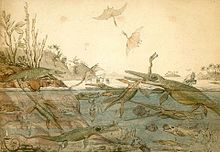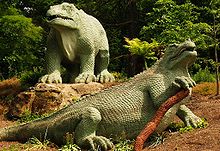illustration
Illustration (v. Latin illustrare "illuminate, explain, praise"; Pl. Illustrations) means "the explanatory picture attached to a text", regardless of its form or specific function.
Metaphorically, however, illustration is also used to describe the process of linguistic explanation, i.e. the visualization and understanding of a situation.
Simply put, illustrations are images in books or for various texts. They determine or indicate what the author has imagined.
history
Illustrations can already be found in antique scrolls and codices , albeit rarely (see late antique book illumination ).
In the Middle Ages , d. H. Before the invention of the art of printing and the technical reproduction that was possible with it, i.e. in manuscripts , painted book miniatures were used as illustrations - one then speaks of "illumination" or " book painting " , for example in the form of initials . According to Gutenberg , woodcuts were generally used - analogous to the printing of the text in movable letters - which in individual cases were also hand-colored.
An important historical phase for illustration art was the Reformation period . It led to a high point in the widespread use of leaflets , which in mass production often largely dispensed with text; the audience was generally illiterate.
The woodcut process was superseded by copper engraving around 1600 , which was then replaced by numerous other techniques in the centuries to come - right up to the perfect modern color printing . Above all, xylography (= wood engraving as opposed to woodcut ) became the dominant illustration technique in books in the 19th century. Later, the technique of lithography (= stone printing ) developed by Alois Senefelder in Munich was added.
With the advent of photography, graphic illustration moved into the background. The explanatory illustration, on the other hand, developed into information graphics .

use
Scientific illustration
Since the early modern era, illustrations in scientific textbooks have been added to texts that can only be conveyed clearly with pictures, for example in anatomical illustrations, in so-called herbal books or in technical descriptions. The illustration acquired a special meaning here through the research of the Académie under Colbert . Based on this tradition, the encyclopedists under Diderot and d'Alembert rely on the didactic effect of the illustration and use it for the first time on a large scale (technique: etching ).
One form of scientific illustration is the "paleoart" (the English term was coined by Mark Hallett ). Paleoart can, however, not only be executed as a two-dimensional illustration, but also as a three-dimensional sculpture, for example by Heinrich Harder (1858–1935). The Society of Vertebrate Paleontology has awarded the John J. Lanzendorf PaleoArt Prize for particularly worthy Paleoart since 1999 .
- Important representatives : Robert T. Bakker , Zdeněk Burian , Gerhard Heilmann , Doug Henderson , Charles R. Knight , Gregory S. Paul , Velizar Simeonovski , Rudolph F. Zallinger
Literary illustration
In terms of cultural history, the development of literary illustration since the 18th century is more important. Increasingly, the readership of the bourgeois age insisted on adding images, and so a large number of artists in this sector of art history have created important works.
- Important representatives : Daniel Chodowiecki (among others on Lessing and Goethe ), Bonaventura Genelli and John Flaxman (among others on Homer ), Moritz Retzsch (among others on Goethe's Faust ), Johann Christian Ruhl (among others on Gottfried August Bürger and on Ossian ), Julius Nisle ( to Johann Peter Hebel ), Peter Cornelius (to Goethe's Faust ), Julius Schnorr von Carolsfeld (to the Bible ), Eugène Delacroix (to Shakespeare's Hamlet ), Gustave Doré (to Dante , John Milton , Cervantes and Charles Perrault , among others , all also in German translation), Wilhelm von Kaulbach ( inter alia on Goethe's Reineke Fuchs ), Ludwig Richter (inter alia on Ludwig Bechstein's fairy tales ), Ludwig Pietsch ( inter alia on Theodor Storms Immensee and Unter dem Tannenbaum ).
Literary illustration gained particular importance in the “ Arts and Crafts ” movement in England from the middle of the 19th century. A fundamental rethinking of the dignity of craftsmanship and the simultaneous beauty of all objects of daily use, especially books, stimulated a formal renaissance of book illustration in early modern times between William Morris and Aubrey Beardsley . H. especially in the so-called " Art Nouveau " and its German variant, the " Art Nouveau ", or the Vienna Secession .
- Important representatives : Louis Maurice Boutet de Monvel , Eugène Grasset , Gaston de Latenay , Alfons Mucha , Lajos Kozma , Fidus , Franz Stassen , Emil Preetorius , Alfred Kubin , Karl Rössing , Berthold Löffler , Olaf Gulbransson , Thomas Theodor Heine , Melchior Lechter , Ignatius Taschner , Marcus Behmer , Albert Weisgerber , Félix Vallotton , Heinrich Vogeler , Heinrich Lefler , Carl Otto Czeschka , Franz Wacik , Iwan Bilibin , Walter Crane , Josef von Diveky , Koloman Moser , Arthur Rackham , Maxfield Parrish , Edmond Dulac , Harry Clarke , Else Wenz-Viëtor , Ruth Koser-Michaëls .
There were also strong influences on literary illustration from numerous neighboring areas, such as caricature or cartoon .
- Important representatives : Albert Dubout , A. Paul Weber , Robert Högfeldt , Paul Flora , Kurt Halbritter , Guillermo Mordillo , Edward Gorey , Walter Moers , Brian Bagnall , Wilhelm Maier-Solgk .
The most interesting and innovative branch of literary illustration since early modernism is still that in picture books and children's books . There it plays an increasingly important role.
- Important representatives : Alan Aldridge , Carl Busse , Étienne Delessert , Maurice Sendak , Eric Carle , Wolf Erlbruch , Sabine Friedrichson , Mario Grasso , Janosch , Eva Johanna Rubin , Rotraut Susanne Berner , Jutta Bauer , Lisbeth Zwerger , Luis Murschetz , Friedrich Karl Waechter , Renate Seelig , Byron W. Sewell , Nikolaus Heidelbach , Roberto Innocenti , Jacky Gleich , Gennady Spirin , Hans de Beer , Marcus Pfister , Rene Borst , Lothar Meggendorfer
In adult fiction it was cultivated in the GDR or by the Gutenberg Book Guild in Frankfurt.
- Important representatives : Max Schwimmer , Werner Klemke , Hans Ticha , Klaus Ensikat , Michael Mathias Prechtl , Bernhard Jäger , Kay Voigtmann , Hans Traxler , Dieter Goltzsche
Illustration in art history
Like no other humanities, the history of art is forced to rely on images in research and in conveying its own subject matter. From the very beginning she used this didactic tool in manuals and overview works. It is true that innovations such as photography , slides and the “new media” and their influence on the subject are controversial. The medial communication, however, to which this subject is subject, is usually left out.
Commercial illustration
In the last 50 years, "commercial illustration" has grown in importance, especially in advertising and product packaging . Illustration is used here to make a quickly perceptible visualization of information accessible to the viewer, which is intended to “illustrate” (“illuminate” in the sense of “make non-textual information”) in addition to the text in the classic sense. Examples of this are instructions for use and exploded views . Illustrations are also often used to convey “moods”, which give the advertised product a connotation that is insufficiently conveyable through textual information or an emotionally charged mood (for example a “nostalgic”, “modern” or “aggressive” mood).
Illustration was and is also used in (advertising) film production and for sketching so-called "layouts", so that in the first phase of the presentation of a campaign to a client, no photographs have to be used through graphic visualizations, since during their production by the to be used Means the costs incurred would be much higher than they are from a few drawings. These forms of illustration do not reach the public (so-called “below the line” illustration). Advertising illustrations that appear in print, be it as a poster , as an advertising motif or as a moving image in animation, are public .
Editorial illustration
Another area is that of "editorially" used illustration: in newspapers , magazines and also on websites and social media portals.
Figure legend
In a figure legend, the content of the image should be commented on with short and precise captions and the author should be named. To avoid confusion, images, including graphics, are numbered consecutively. Possibly. this only happens chapter by chapter. In a single work, the order of recurring information in the legends should be identical; z. B. Figure number, author, year, original size (width times height in SI units), title. A further description follows in a next, indented line, one-line spacing. For the understanding of the text it would be better if this happened in the running text. Figures should provide additional information and be anchored in the text by means of references.
Publishers very often have their own guidelines for authors, which can contain further information on image quality, size, labeling and delivery.
See also
- Picture book
- Panel
- Book illustration
- Comic
- Illustration prize for books for children and young people
- Illustrative
- Illustrator (profession)
- Illustrators of children's and youth literature
- Illustrated
- Children's book house in the Altona Museum
- List of famous illustrators
literature
- DIN, German Institute for Standardization eV (Hrsg.): Presentation technique for dissertations and scientific work. DIN standards. 2nd, modified edition. Beuth, Berlin / Vienna / Zurich 2000, ISBN 3-410-14816-7 .
- Dieter Scholz: Writing diploma theses in accordance with standards. Writing tips for the design of study, diploma and doctoral theses. 2nd Edition. Vogel, Würzburg 2006, ISBN 3-8343-3034-5 .
Web links
- Illustrator Organization eV (IO)
- On the history of nature illustration
- Stuttgart Database of Scientific Illustrators 1450-1950 (DSI) (with almost 7000 entries and 20 search fields)
- Foundation illustration
Individual evidence
- ↑ See also Wolfgang Eckart : On the function of the image as a medium of science communication in the medical literature of the 17th century. In: Reports on the history of science. Volume 3, 1980, pp. 35-52.
- ↑ Catherine Thimmesh: Scaly Spotted Feathered Frilled: How Do We Know What Dinosaurs Really Looked Like? Houghton Mifflin Harcourt, 2013, with illustration examples by John Sibbick , Greg Paul , Mark Hallett, and others ISBN 978-0-547-99134-4 .
- ^ Lanzendorf PaleoArt Prize . Society of Vertebrate Paleontology .

